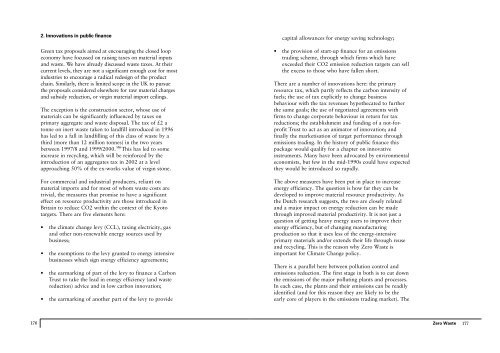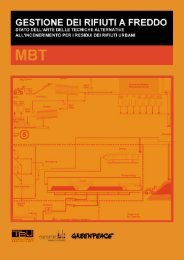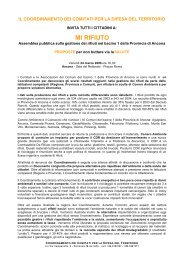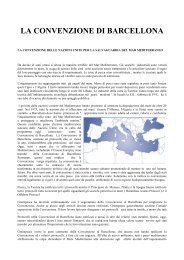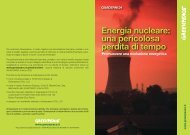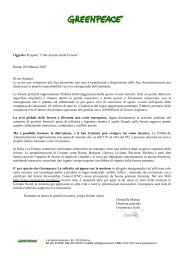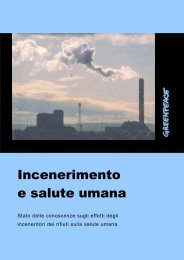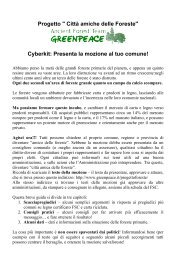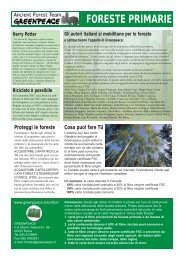Zero Waste by Robin Murray, Greenpeace Environmental Trust 2002
Zero Waste by Robin Murray, Greenpeace Environmental Trust 2002
Zero Waste by Robin Murray, Greenpeace Environmental Trust 2002
You also want an ePaper? Increase the reach of your titles
YUMPU automatically turns print PDFs into web optimized ePapers that Google loves.
2. Innovations in public finance<br />
G reen tax proposals aimed at encouraging the closed loop<br />
economy have focussed on raising taxes on material inputs<br />
and waste. We have already discussed waste taxes. At their<br />
c u rrent levels, they are not a significant enough cost for most<br />
industries to encourage a radical redesign of the pro d u c t<br />
chain. Similarly, there is limited scope in the UK to pursue<br />
the proposals considered elsewhere for raw material charg e s<br />
and subsidy reduction, or virgin material import ceilings.<br />
The exception is the construction sector, whose use of<br />
materials can be significantly influenced <strong>by</strong> taxes on<br />
primary aggregate and waste disposal. The tax of £2 a<br />
tonne on inert waste taken to landfill introduced in 1996<br />
has led to a fall in landfilling of this class of waste <strong>by</strong> a<br />
third (more than 12 million tonnes) in the two years<br />
between 1997/8 and 1999/2000. 110 This has led to some<br />
increase in recycling, which will be reinforced <strong>by</strong> the<br />
introduction of an aggregates tax in <strong>2002</strong> at a level<br />
approaching 50% of the ex-works value of virgin stone.<br />
For commercial and industrial producers, reliant on<br />
material imports and for most of whom waste costs are<br />
trivial, the measures that promise to have a significant<br />
effect on resource productivity are those introduced in<br />
Britain to reduce CO2 within the context of the Kyoto<br />
targets. There are five elements here:<br />
• the climate change levy (CCL), taxing electricity, gas<br />
and other non-renewable energy sources used <strong>by</strong><br />
business;<br />
• the exemptions to the levy granted to energy intensive<br />
businesses which sign energy efficiency agreements;<br />
• the earmarking of part of the levy to finance a Carbon<br />
<strong>Trust</strong> to take the lead in energy efficiency (and waste<br />
reduction) advice and in low carbon innovation;<br />
• the earmarking of another part of the levy to provide<br />
capital allowances for energy saving technology;<br />
• the provision of start-up finance for an emissions<br />
trading scheme, through which firms which have<br />
exceeded their CO2 emission reduction targets can sell<br />
the excess to those who have fallen short.<br />
There are a number of innovations here: the primary<br />
resource tax, which partly reflects the carbon intensity of<br />
fuels; the use of tax explicitly to change business<br />
behaviour with the tax revenues hypothecated to further<br />
the same goals; the use of negotiated agreements with<br />
firms to change corporate behaviour in return for tax<br />
reductions; the establishment and funding of a not-forprofit<br />
<strong>Trust</strong> to act as an animator of innovation; and<br />
finally the marketisation of target performance through<br />
emissions trading. In the history of public finance this<br />
package would qualify for a chapter on innovative<br />
instruments. Many have been advocated <strong>by</strong> environmental<br />
economists, but few in the mid-1990s could have expected<br />
they would be introduced so rapidly.<br />
The above measures have been put in place to increase<br />
energy efficiency. The question is how far they can be<br />
developed to improve material resource productivity. As<br />
the Dutch research suggests, the two are closely related<br />
and a major impact on energy reduction can be made<br />
through improved material productivity. It is not just a<br />
question of getting heavy energy users to improve their<br />
energy efficiency, but of changing manufacturing<br />
production so that it uses less of the energy-intensive<br />
primary materials and/or extends their life through reuse<br />
and recycling. This is the reason why <strong>Zero</strong> <strong>Waste</strong> is<br />
important for Climate Change policy.<br />
There is a parallel here between pollution control and<br />
emissions reduction. The first stage in both is to cut down<br />
the emissions of the major polluting plants and processes.<br />
In each case, the plants and their emissions can be readily<br />
identified (and for this reason they are likely to be the<br />
early core of players in the emissions trading market). The<br />
176<br />
<strong>Zero</strong> <strong>Waste</strong><br />
177


